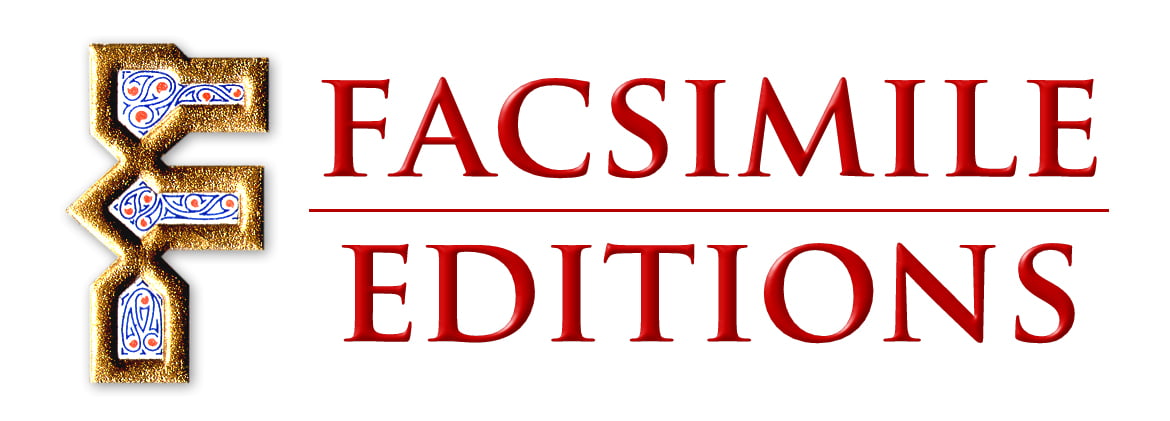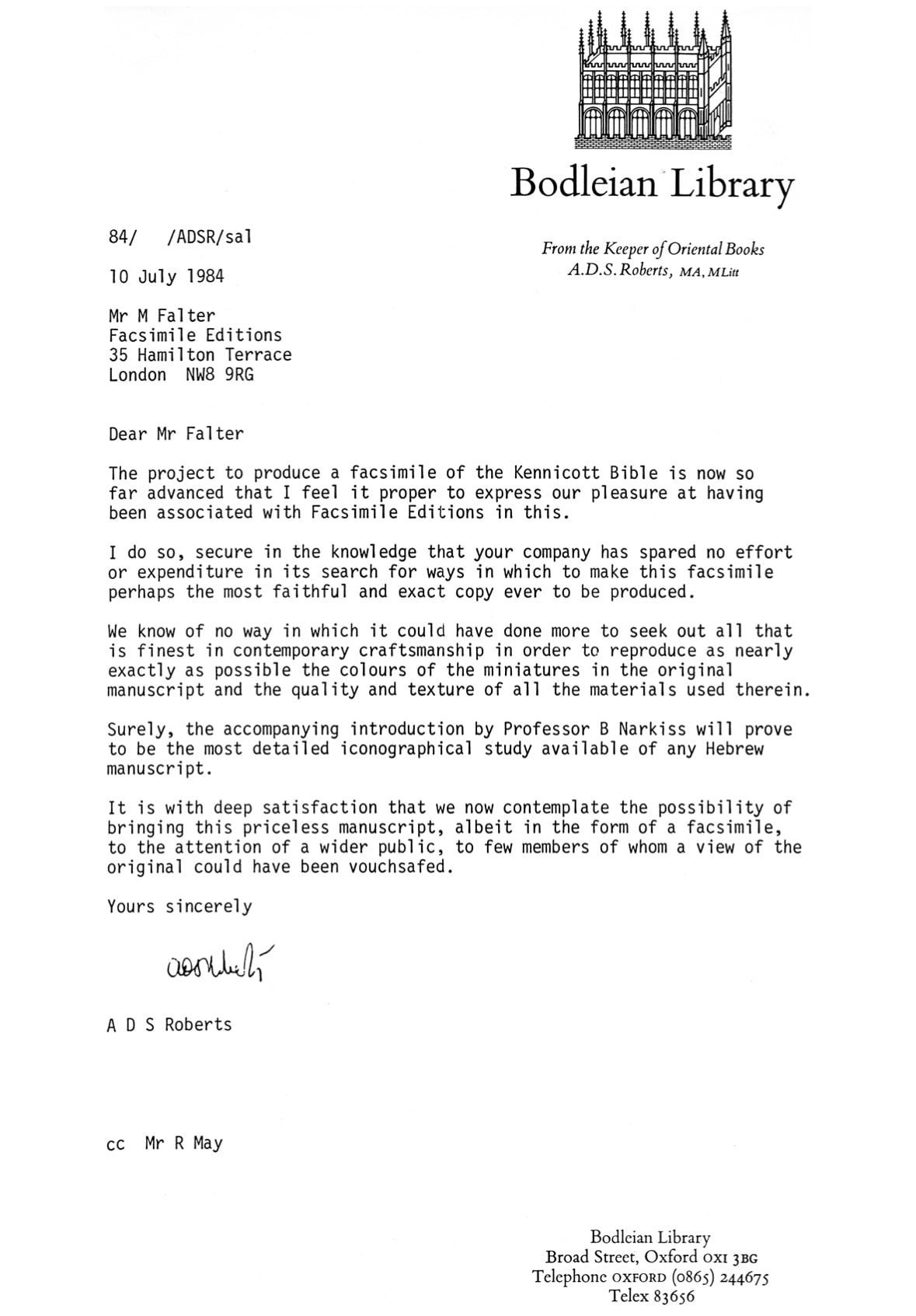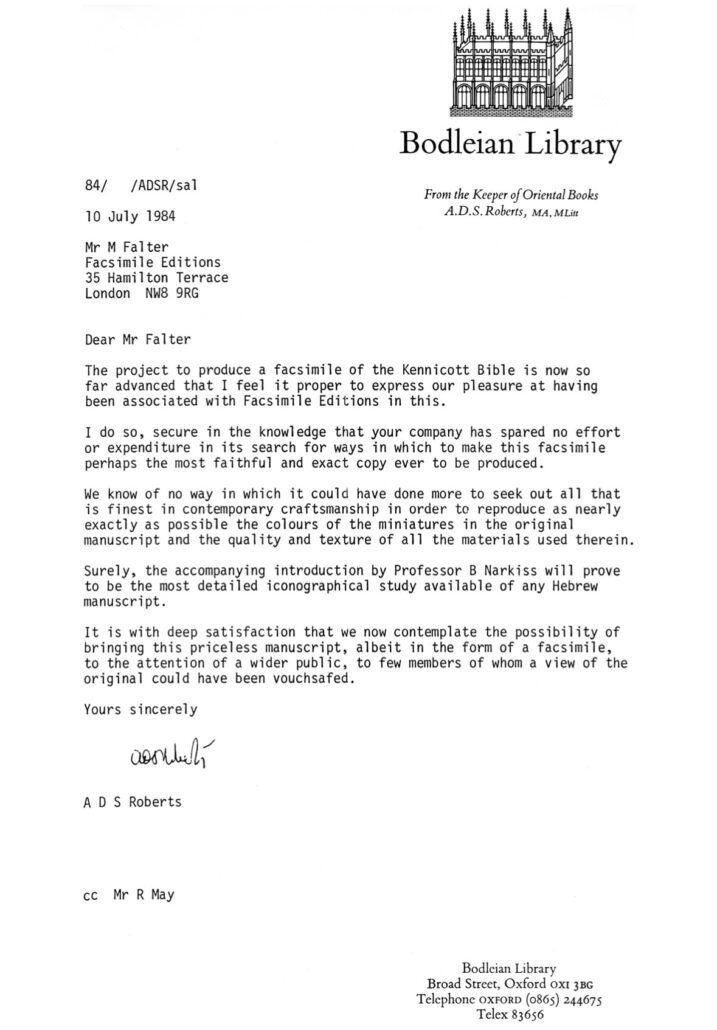Kennicott Bible
The famous Kennicott Bible, MS Kennicott 1, is the most lavish Hebrew Bible in existence. The manuscript is illuminated throughout its 922 pages and contains the entire Tenakh (Old Testament) together with RaDaK’s (Rabbi David Kimchi) Sefer Mikhlol, a grammatical treatise on the Tenakh.
INTRODUCTION
Published as a sumptuous facsimile after five and a half years in the making, the Kennicott Bible facsimile, inspired and enthusiastically supported by the late David Patterson, was acclaimed by the Bodleian and many other libraries, as the highest quality that had ever been achieved in a facsimile. This was partly due to the excellent condition of the original manuscript, but to a greater extent to the unrelenting quest for perfection at every stage of its reproduction.
INTRODUCTION
Published as a sumptuous facsimile after five and a half years in the making, the Kennicott Bible facsimile, inspired and enthusiastically supported by the late David Patterson, was acclaimed by the Bodleian and many other libraries, as the highest quality that had ever been achieved in a facsimile. This was partly due to the excellent condition of the original manuscript, but to a greater extent to the unrelenting quest for perfection at every stage of its reproduction.
Photography
Before reproduction could commence, the manuscript had to be photographed, an especially difficult task considering that disbinding of the manuscript was not permitted and the sides of the box binding prevented easy access of the large-format camera. The Bodleian Library’s photographic department nonetheless overcame these seemingly insuperable problems and produced a fine set of images of each of the manuscript’s 922 pages.
Colour Separation and Proofing
In order to reveal up to 24 different colours applied by the artist in a single square inch of design, laser scanners were used to produce the first set of colour separations. Printed ‘wet’ proofs on the same paper that was to be used in the facsimile, were then compared against the original manuscript and adjustments noted on the proofs to be corrected later, by hand, by the colour separators in Milan. As many as four sets of proofs were made and compared against the original in Oxford in order to achieve perfect colour fidelity before printing. To ensure and maintain the quality of colour and accuracy of detail while printing, Linda and Michael Falter stood at the printing press and personally checked and approved the quality of every sheet for the duration of the printing process.
Paper
Not satisfied merely to reproduce the appearance of parchment, the original folios were studied and measured for their thickness, weight and opacity. One of the oldest Italian paper mills was commissioned to produce a paper with the unique transparency, presence and feel of parchment. Taking more than a year to develop, the paper is so close in appearance and feel to real parchment that it leads many experts to believe it to be skin!
Photography
Before reproduction could commence, the manuscript had to be photographed, an especially difficult task considering that disbinding of the manuscript was not permitted and the sides of the box binding prevented easy access of the large-format camera. The Bodleian Library’s photographic department nonetheless overcame these seemingly insuperable problems and produced a fine set of images of each of the manuscript’s 922 pages.
Colour Separation and Proofing
In order to reveal up to 24 different colours applied by the artist in a single square inch of design, laser scanners were used to produce the first set of colour separations. Printed ‘wet’ proofs on the same paper that was to be used in the facsimile, were then compared against the original manuscript and adjustments noted on the proofs to be corrected later, by hand, by the colour separators in Milan. As many as four sets of proofs were made and compared against the original in Oxford in order to achieve perfect colour fidelity before printing. To ensure and maintain the quality of colour and accuracy of detail while printing, Linda and Michael Falter stood at the printing press and personally checked and approved the quality of every sheet for the duration of the printing process.
Paper
Not satisfied merely to reproduce the appearance of parchment, the original folios were studied and measured for their thickness, weight and opacity. One of the oldest Italian paper mills was commissioned to produce a paper with the unique transparency, presence and feel of parchment. Taking more than a year to develop, the paper is so close in appearance and feel to real parchment that it leads many experts to believe it to be skin!
Printing
Facsimile Editions sought out a company that for generations had practised the Master Printer’s craft. Grafiche Milani in Italy regarded the reprinting of the manuscript as a supreme challenge in which the entire workforce would strive to produce a work of unparalleled, consummate beauty. Their ingenuity, dedication and integrity ensured perfect reproduction of the lavish gold and silver and the intricate yet vibrant colours of the hundreds of illuminated pages. Many processes and materials were used in unusual combinations to produce these effects.
Gilding
Reproducing the extensive gold and silver metal leaf of the original was a major challenge which was eventually completed by seven craftsmen working continuously for four months applying leaf by hand to each illumination.
Holes
The scribe would have bought the very best parchment available, but occasionally a skin would have a hole in it. As parchment was costly, the scribe could not afford to discard it so he would carefully circumscribe the text around a hole. For the two holes in the facsimile to appear in exactly the same position as the holes in the manuscript, the printing on each side of the leaf had to be positioned with perfect relative precision so that when the hole was cut no text was damaged on either side of the leaf.
Printing
Facsimile Editions sought out a company that for generations had practised the Master Printer’s craft. Grafiche Milani in Italy regarded the reprinting of the manuscript as a supreme challenge in which the entire workforce would strive to produce a work of unparalleled, consummate beauty. Their ingenuity, dedication and integrity ensured perfect reproduction of the lavish gold and silver and the intricate yet vibrant colours of the hundreds of illuminated pages. Many processes and materials were used in unusual combinations to produce these effects.
Gilding
Reproducing the extensive gold and silver metal leaf of the original was a major challenge which was eventually completed by seven craftsmen working continuously for four months applying leaf by hand to each illumination.
Holes
The scribe would have bought the very best parchment available, but occasionally a skin would have a hole in it. As parchment was costly, the scribe could not afford to discard it so he would carefully circumscribe it in the text. The two holes in the facsimile were cut to appear in exactly the same position as the holes in the manuscript. This meant that not only did the printing have to register perfectly on each side of the page but the printing of both sides of the page had to be positioned with perfect relative precision so that when the hole was cut no text was damaged.
Binding
Finding a binder to accurately copy the original binding of the original manuscript was not easy. Blind-embossed in minute detail on all six surfaces, its style is extremely rare – only six box-bindings are known to exist – but it is this binding that has preserved the manuscript for more than half a millennium.
In order to create the handmade brass dies used to emboss the soft morocco, Master engravers painstakingly traced the box’s detailed design in a time-consuming and costly process carried out for the Milanese atelier of the renowned Angelo Recalcati.
No effort was spared in reproducing the cut-out paste-downs which decorate the inside front and back covers, both of which are painted beneath intricate cut-out interlacing bands. Once bound, the edges of each leaf were gilt with 23 carat gold.
Presentation
The facsimile and commentary volume are presented together in an elegant presentation case.
Personalised Dedication
The facsimile can be personally dedicated by an expert calligrapher at no extra charge. Whether the facsimile is intended as a gift to an institution or a private individual, our calligrapher can inscribe a beautifully decorated certificate with an inscription of your choice.
Presentation
The facsimile and commentary volume are presented together in an elegant presentation case.
Personalised Dedication
The facsimile can be personally dedicated by an expert calligrapher at no extra charge. Whether the facsimile is intended as a gift to an institution or a private individual, our calligrapher can inscribe a beautifully decorated certificate with an inscription of your choice.
Commentary Volume
The study of the Kennicott Bible and its illuminations was carried out and written especially for this facsimile by Professor Bezalel Narkiss, Founder of the Centre for Jewish Art, Jerusalem, and Dr Aliza Cohen-Mushlin, its Director.
Specification
Codicology
Bodleian Library MS. Kennicott 1
ISBN 0 948223 006
922 pages, 238 illuminated pages with gold and silver
24 canonical book headings
49 parashah headings structured with gold in different motifs featuring zoomorphic figures in many colours
27 lavishly-illuminated arcaded pages framing the text of the Sefer Mikhlol
9 fully illuminated carpet pages
150 psalm headings, numbered and illuminated with gold and silver
Page size 320 x 262 x 100mm (12½” x 10⅓” x 4″)
Paper
Specially and exclusively milled for this facsimile on
neutral pH, 160gsm, vegetable parchment paper.
The opacity, feel and thickness are almost identical to the original manuscript.
Colour Separation & Proofing
Laser scanning and skilled hand correction
Perfect colour matching by constant comparison to the original in Oxford
Up to four sets of ‘wet’ proofs made for each page
Printing
Offset lithography in eleven colours
Publishers personally supervised the production of every sheet.
Paper
Specially and exclusively milled for this facsimile on
neutral pH, 160gsm, vegetable parchment paper.
The opacity, feel and thickness are almost identical to the original manuscript.
Colour Separation & Proofing
Laser scanning and skilled hand correction
Perfect colour matching by constant comparison to the original in Oxford
Up to four sets of ‘wet’ proofs made for each page
Printing
Offset lithography in eleven colours
Publishers personally supervised the production of every sheet.
Gilding
Gold and silver metal foils applied by hand to each illumination
Seven craftsmen took over four months to complete
Binding
Finest morocco goatskin box-binding
Interlacing geometric designs embossed using handmade dies on all six sides
Facsimile edges gilt with 23 carat gold leaf
Presentation
Facsimile and commentary volume enclosed in velvet lined, portfolio box
Gift Certificate
Beautifully decorated gift certificate with a personal inscription is offered at no additional charge
Shipping & Insurance
Price includes insurance and courier delivery
Edition
• Strictly limited to 500 numbered and 50 Ad Personam copies. Each volume, discreetly numbered by hand on the inside back cover using minute steel dies, is accompanied by a numbered and signed certificate carrying the seal of the Bodleian Library.
• On completion of the edition, the printing plates were destroyed (in a process that accords with halachic requirements) so as to protect the significant investment value of each facsimile.
See explanatory letter from London Beth Din



















